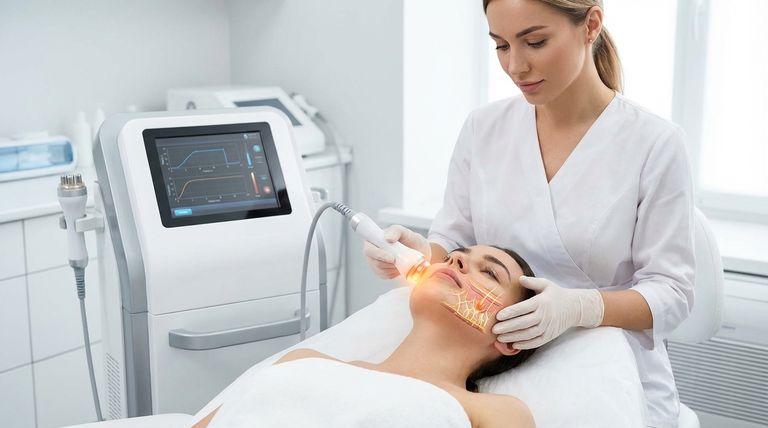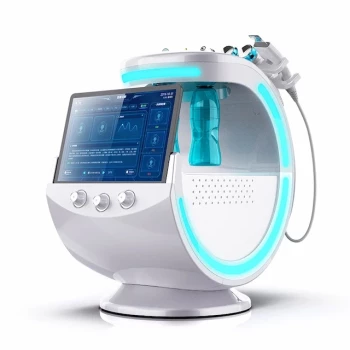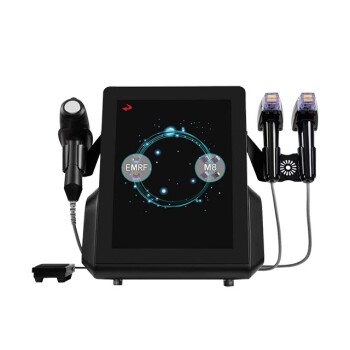At its core, a radiofrequency (RF) machine works by using electrical energy to generate controlled heat deep within your skin. This process bypasses the surface layer, targeting the foundational dermis where collagen is produced. The heat triggers your body's natural wound-healing response, stimulating the creation of new collagen and elastin, which in turn helps tighten skin and reduce the appearance of wrinkles.
RF therapy is not a surface treatment. It is a method of inducing a controlled thermal effect in the skin's deep structural layers to kickstart your body's own regenerative processes for a firmer, more youthful appearance over time.

The Core Mechanism: From Electricity to Collagen
To truly understand how an RF machine functions, you must see it as a tool that leverages your body's own biology. The machine itself doesn't "add" anything; it simply creates the precise conditions for your skin to rebuild itself.
Understanding Radiofrequency Energy
Radiofrequency is a form of electrical energy. It sits on the lower end of the electromagnetic spectrum, and the energy used in aesthetic treatments is considered low-energy and safe.
This is not ionizing radiation like X-rays. Think of it more like the energy used for Wi-Fi or radio waves, but precisely controlled and delivered to create a specific biological effect.
Creating Resistance and Heat
The fundamental principle at work is that tissues in the body have a natural resistance to electrical currents. When the RF machine delivers energy into the skin, the dermis resists this flow.
This resistance converts the electrical energy into thermal energy, or heat. The process is precise, allowing a practitioner to heat the dermal layer to an optimal temperature (typically 40-44°C) required for collagen stimulation.
Targeting the Dermis, Sparing the Epidermis
A key feature of modern RF devices is their ability to protect the skin's surface (the epidermis). Many machines incorporate cooling mechanisms on the handpiece.
This allows the surface to remain comfortable while the RF energy penetrates and heats the deeper dermis. This selective heating is critical for both safety—preventing surface burns—and efficacy, as it ensures the energy reaches the fibroblasts responsible for collagen production.
The Biological Response: Neocollagenesis
The heat generated by the RF device creates a controlled "thermal injury" in the dermis. Your body perceives this as a wound that needs healing.
This signal activates cells called fibroblasts, which are the collagen factories in your skin. They begin to produce new, healthy collagen and elastin fibers in a process called neocollagenesis.
This new collagen matrix is denser and more organized, providing the underlying structure that results in firmer, thicker, and smoother-looking skin.
Understanding the Trade-offs and Limitations
While the science is sound, it is crucial to approach RF therapy with a clear understanding of what it can and cannot do.
It's a Process, Not an Instant Fix
While some immediate tightening may be visible due to collagen fiber contraction, the true results are gradual. It takes your body time to produce new collagen.
Meaningful improvements typically appear over two to six months following the treatment series as the new collagen structure is built.
Efficacy Varies
Results depend heavily on the specific device used, the treatment protocol, and the skill of the operator. The power, frequency, and cooling technology of the machine play a significant role.
Furthermore, individual factors like age, skin condition, and lifestyle choices will influence the final outcome.
Best for Mild to Moderate Laxity
RF therapy is highly effective for treating early signs of aging, such as fine lines, mild wrinkles, and a slight loss of firmness.
It is not a substitute for a surgical facelift. For individuals with significant skin sagging or deep, static wrinkles, RF may offer only modest improvement or be best used in combination with other procedures.
Making the Right Choice for Your Goal
Understanding the mechanism of RF helps you align the treatment with your personal aesthetic goals.
- If your primary focus is proactive anti-aging or treating early fine lines: RF therapy is an excellent, minimally invasive option to stimulate collagen and maintain skin quality over the long term.
- If your primary focus is correcting moderate skin laxity: RF can provide noticeable firming and tightening, but it's essential to have realistic expectations and commit to a full series of treatments.
- If your primary focus is safety and effectiveness: Always seek treatment from a qualified, certified provider who uses a medical-grade, FDA-cleared device to ensure a safe and predictable outcome.
By understanding the science, you can move beyond the hype and make an informed decision based on the specific needs of your skin.
Summary Table:
| Key Aspect | How an RF Machine Works |
|---|---|
| Core Mechanism | Uses electrical energy (radiofrequency) to generate controlled heat deep within the skin's dermis. |
| Primary Target | The dermal layer, where collagen and elastin are produced. The epidermis (surface) is protected by cooling. |
| Biological Effect | Heat triggers a natural wound-healing response, stimulating fibroblasts to produce new collagen (neocollagenesis). |
| Key Benefit | Non-invasive skin tightening and wrinkle reduction by rebuilding the skin's underlying structure. |
| Result Timeline | Gradual improvement over 2-6 months as new collagen forms. Not an instant fix. |
Ready to integrate professional, results-driven RF technology into your practice?
BELIS specializes in high-performance medical aesthetic equipment, providing medical aesthetics clinics and premium beauty salons with the advanced tools needed to deliver safe and effective treatments. Our professional RF machines are designed for optimal collagen stimulation and patient satisfaction.
Contact our experts today to learn how our RF solutions can enhance your service offerings and grow your business.
Visual Guide

Related Products
- IPL SHR+Radio frecuency machine
- Cryolipolysis Fat Freezing Machine and Ultrasonic Cavitation Device
- Ultrasonic Cavitation Radiofrecuency Machine for Body Slimming
- RF Microneedling Machine Micro Needle Radio Frequency Machine
- Hydrofacial Machine with Facial Skin Analyzer and Skin Tester
People Also Ask
- Is it safe to use RF machine everyday? Avoid These Risks for Optimal Results
- What is the difference between SHR and laser hair removal? Choose the Right Method for You
- What does radiofrequency do to your body? Understanding Thermal Effects for Safe Treatments
- How often do you need RF? Achieve Optimal Skin Tightening with the Right Schedule
- How does SHR hair removal work? A Gentle, In-Motion Technology for Permanent Results



















